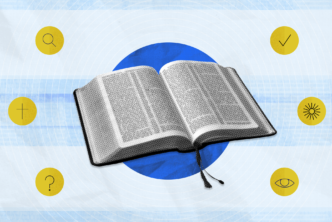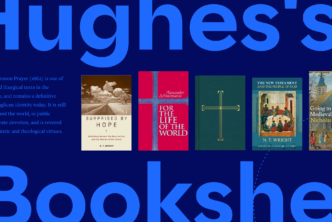Rick Brannan has just finished an important side project on early Christian papyri: Fragments of Christianity —now available for pre-order on Logos. Keep reading to learn what Rick Brannan says about the book—and how it can help us understand early Christians better.
Chances are good you’ve used a resource Rick Brannan has worked on, if you’ve ever used Logos Bible Software. He’s helped to create resources like the SBL Greek New Testament, the Lexham English Septuagint, the Apostolic Fathers Greek-English Interlinear, and the Greek Apocryphal Gospels, Fragments, and Agrapha.
We can explore the fragments of parchments that early Christians read, studied, and created to better understand the world that early Christians lived in—and how Christianity looked from its earliest days. That’s why I’ve spent so much time trying to make extant writings from the earliest days of Christianity available for us all (myself included!) to read and study.
And it is why, in the summer of 2018, I started researching, transcribing, and translating fragmentary early Christian papyri from the earliest days of Christianity. The product of that research is my book Fragments of Christianity: Fragmentary Witnesses to Early Christian Liturgies, Hymns, Homilies, and Prayers. The book includes transcriptions, translations, and discussions of 36 fragmentary early Christian papyri. (For the book, “early” is defined as “has a published date within the fifth century AD or before,” so anywhere before AD 499.)
In an environment like Logos Bible Software, you can use Fragments of Christianity to run reference searches to discover relevant information on early Christian papyri to understand the Church’s earliest days.
A papyri fragment about Epiphany
To show you how significant these fragments of early Christian papyri can be, let’s look at the first papyrus in the book, P.Berol. 11633 (image and information), a liturgical fragment that dates to the fifth to sixth centuries. It focuses on events traditionally associated with Epiphany.
One of the events this papyrus interacts with is John the Baptist’s baptism of Jesus (Mark 1:9–11; Matt 3:13–17; Luke 3:21–22; plus direct allusion to John 1:29). If you perform a reference search of Fragments of Christianity for any passage in those ranges, you’ll find a reference to P.Berol. 11633 (among others). You’ll find an allusion to John 1:29, which is great. But the text of the papyrus is even better, I think.
In this excerpt from P.Berol. 11633, the “forerunner” is John the Baptist (cf. Isa 40:3-11; Mal 3:1; the one who “goes before” the Messiah). Pay careful attention to the conversation between John and Jesus in the relevant portion (P.Berol. 11633, lines 29-45):
(29) We were filled with great joy (30) upon seeing the Jordan (31) when the one born upon earth as a man (32–34) appeared in it and the forerunner himself listened to your voice saying, “Let us (35) complete the plans of the Father.” (36) “Like the Lord wanted,” (37) said John.
You, Christ, came down (38) into the water, The mountains leaped (39) like rams and the hills like a lamb (40) of the sheep. As you arose (41) from the Jordan a voice has (42) come from the sky to you (43) “This one is my beloved (44) Son in whom I am well pleased. (45) Fear him.”
Did you catch that interaction between Jesus and John? Here’s what I wrote in Fragments of Christianity (p. 10):
After this is perhaps the most normal, human portion of the entire liturgy. Before the baptism of Jesus happens, John and Jesus have a brief conversation. The words “Let us complete the plans of the Father” are put in the mouth of Jesus, with an immediate response from John of “Like the Lord wanted” (34–37). The moment reads almost as a whispered conversation between the two primary participants immediately prior to the actual act of baptism. In the context of the liturgy, the conversation also confirms that John the Baptist and Jesus knew exactly what they were doing and knew the impact of the baptism. Unlike the canonical accounts of Jesus’ baptism which record John’s protestations about not being worthy (Matt 3:14–15), this account paints John as in tune with the will of God and willing to perform the baptism without hesitation.
Now, to be clear, I’m not saying that this papyrus is evidence that this interaction actually occurred. But this is how it was styled within 400–500 years of the event and how it was portrayed in liturgical contexts in the early Church. I love the picture of Jesus and John sharing a word between themselves while this was happening; it just makes me smile.
What else can we learn from early Christian papyri?
Fragments of Christianity includes papyri that have to do with Epiphany and with Jesus’ trial, crucifixion, and resurrection.
It includes a prayer (P.Cair. 10263) reportedly found buried with a mummy that references Jesus as the one who “snapped off the claw of Charon” (the mythical gatekeeper of the underworld).
It also includes sermons that interact with text from the gospels (P.Geneva 3.125; P.Land. 5.69), as well as one that seems to focus on Barabbas and the role of the chief priests in Christ’s trial and crucifixion (PSI inv. 535).
There are a couple of examples of hymns structured as alphabetic acrostics (P.Amh. Gr. 1 2; P.Berol. 8299).
And there is so much more. More to learn about how early Christians viewed these texts and events. More to learn about early Christian liturgy. More to learn about how early Christians prayed.
If you value the incorporation of early Christian texts in your study of the Bible, then I invite you to consider adding Fragments of Christianity to your Logos library now.
***

Learn more about Fragments of Christianity: Fragmentary Witnesses to Early Christian Liturgies, Hymns, Homilies, and Prayers, and pre-order now to get the best price!





